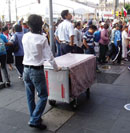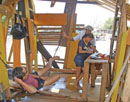The reflection of artists on their artworks’ circulation spaces is simultaneous to the emergence of the first museums. The opening to the public back in the 17th and 18th centuries of the first private collections and then the appearance of State-run institutions contributed to making a sea change in the way of understanding the arts, something that in the past had solely been reserved for religious cults and the praising of monarchy and aristocracy. The first artists of the modern times, right in the dawn of romanticism, portrayed cabinets jam-packed with an untidy assortment of artworks, curiosities and antiques that piled up from the floor all the way to the ceiling.
Even though they firmly believed back then that their pieces had a universal and absolute sense, they did know the layout of that circulation space made up of institutions, “halls”, critics and the new academies had something to do with sense-building. It’s easier today to comprehend that both the symbolic and economic values of an artwork are woven in a complex set of interactions, that sense is not an a priori, but rather the result of a long process that kicks off the moment the creator shows his work to the world. That’s what Marcel Duchamp’s celebrated urinal laid bare in 1917, as well as the ready-mades that followed. It’s the context and the relationship between the object and the spectator what actually determines the artistic nature. It’s not the materials or the techniques, or whether it’s a painting or a sculpture.
Back in the 1970s, the term institutional critique caught on when referring to the works of such artists as Marcel Broodthaers or Hans Haacke, who practiced a radical disarticulation of the art institution by revealing the trappings of political and economic interests that hide behind culture’s apparent autonomy. Since then, the importance of the contemporary art museum has not stopped growing, nor has the interest of artists in it. Many have got a hold on the art museum, have replicated it in a variety of forms just to criticize or subvert its role in the social order. The first one to ever do that was no other than Marcel Duchamp with his Boîte en Valise, of collection of his own pieces that were making the rounds and being displayed in suitcases between 1935 and 1941. Other artists, like African-American Fred Wilson, have imitated the collecting compulsion of the museum, yet with a specific intention. In the Speak me as I am installation presented in 2003 at the Venice Biennial, he culled videos and other representations of Othello, the only black character in Shakespeare’s work, and put them together with images of “Moorish” people from the Venetian classical art. Just an essay on racism. From a completely different perspective, China’s Cai Guo-Quiang has been creating phony museums since the year 2000, and perhaps the most peculiar of all is the UMoca, a museum built under a bridge during the 6th edition of Arte All’Arte at the Toscaza in 2001.
In the Latin American art, the museum appropriation has normally presented the scarcities of the real institution as a leitmotiv. The existence of highly creative artistic communities deeply committed to the arts and society, mainly in co untries with feeble institutional fabrics, has given rise to a number of clever proposals. Artists and curators, sometimes relying on irony and some other times on the need to implement infrastructures, have thought up minimum museums –sometimes ultra-minimum– that put the debate on the public sector and institutions it’s made up of right on the table.
Two paradigmatic cases in point from recent years were Hofmann’s House in Chile, and Capacete in Brazil. The former was a space opened for the emerging art that used a kind of local hut or shack reserved for emergency situations but it has now become a makeshift housing solution for the poor. It’s a one-room log cabin of barely 160 square feet. Between 1999 and 2003, this shack had an intense schedule in different locations. Capacete is indeed the name of a carioca group that built a portable artistic space in 1999 and named it the Banca. In 2002, a new prototype –Banca 2– was presented at the Sao Paolo Biennial. There’s a description of it on its website (www.capacete.net/ingles/banca.asp) as a multifunctional modular unit made of galvanized metal, acrylic planks, solar panels and wheels that guarantees complete mobility for the creation and exposition of artworks in uncommon places, thus giving artists and curators the possibility of reaching out to people with little or no contact at all with the contemporary art.
A very different approach to the museum is what Peruvian artist Sandra Gamarra has made. She decided to make up for the lack of a contemporary art center in Lima by creating one of her own: The LiMac. This is a fiction museum that from its website (www.li-mac.org) is presented as a real institution. It features programs, collections and merchandising, with the very creator recreating the works of other artists that must be exposed in a Peruvian State-run collection. Also in Peru, curator Gustavo Buntinx has been running for years the Micromuseum project (www.micromuseo.org.pe), one without a brick-and-mortar facility that intends to take up the same institutional slack. It’s a kind of nomad, host or parasite museum. This is what the creator himself had to say about it: “A walking museum, a rolling museum created not to convey cultural power relationships between the downtown and uptown elites, but rather to channel new communities of sense, communities of feelings”.
But the wobbliest of these rolling museums is no doubt the Street Museum (museodelacalle.tripod.com/), created by a group of artists in the city of Bogota. It’s nothing but a small cart that from 1998 to 2000 served to put together a collection of wastes that describe the margins of the human existence. For them, garbage and useless objects, put in the hands of recyclers, are turned back into goods that re-describe the human and social ties.
Mexico is a particularly fertile country when it comes to this kind of initiative. The tradition for the public art inherited from the murals prompts artists time and again to take to the streets as the natural space for the creation and exhibition of their works. In the 1990s, there was the Tacubaya Rolling Museum, just a small truck decked out with popular scenes. Also during those years, artist Vicente Razo created the Salinas Museum in his own bathroom, featuring an astounding collection of images thought up by popular imagination about former Mexican President Carlos Salinas de Gortari.
In 2006, artists Eder Castillo and Rene Hayashi came up with a floating structure, half sculpture and half boat, that was anchored in international waters of the Suchiate river, right in the border between Mexico and Guatemala. Guatemex –that’s how it was called– was an attempt to create a public space for Central American migrants that cross the U.S.-Mexican border. Equipped with a computer and Internet connection, Guatemex (www.pixelkraft.com.mx/guatemex) was a one-of-a-kind cultural institution, partly a museum, partly a refuge and partly a sculpture.
Mexico-based Argentine Maximo Gonzalez runs a peculiar gallery since 2004: El Changarrito (www.pixelkraft.com.mx/guatemex), a minuscule rolling outlet where exposition and other cultural events are held. As a general rule, El Changarrito parasitizes official cultural institutions and events in an effort to inject an alternative platform in all of them. This gallery has also made stops in art fairs, like ARCO in Madrid or Zona MACO in Mexico, the Venice Biennial and countless public spaces across Mexico City.
Finally, the Contemporary Art Antimuseum –a non-lucrative organization the writer of this article belongs to– founded in 2009 the Contemporary Art Portable Center (CPAC). Equally inspired in street vending outlets around Mexico, the CPAC (www.
ojoatomico.com/cpac/index.html) is a ro-
lling structure designed for brief interventions in public spaces. Its objective is to reassess the meaning of the public space and promote fleeting institutional processes. In the course of two months, as many as a dozen different actions in six different parts of the city were held, all of them dealing with the main concerns of their authors and the Mexican society: the city’s unfettered growth, rampant political corruption, the rights of the indigenous population, machismo and women’s rights, or the privatization of the public space. Thanks to the collaboration of creators and activists, the CPAC plunges itself into the metropolis’s lifestyle, mixed up with the tianguis –the name rolling vending outlets are known for– political demonstrations, off-the-cuff concerts and the nonstop flow of the streets.



Previous publication Julio le Parc and light demystification
Next publication Fallen walls, upright walls
Related Publications

How Harumi Yamaguchi invented the modern woman in Japan
March 16, 2022












